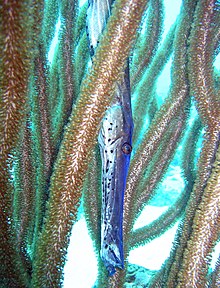Aulostomus maculatus
| West Atlantic trumpetfish | |
|---|---|

| |
| Scientific classification | |
| Domain: | Eukaryota |
| Kingdom: | Animalia |
| Phylum: | Chordata |
| Class: | Actinopterygii |
| Order: | Syngnathiformes |
| Family: | Aulostomidae |
| Genus: | Aulostomus |
| Species: | A. maculatus
|
| Binomial name | |
| Aulostomus maculatus Valenciennes, 1841
| |
| Synonyms[2] | |
Aulostomus maculatus, the West Atlantic trumpetfish, is a long-bodied fish with an upturned mouth. It often swims vertically while trying to blend with vertical coral, such as sea rods, sea pens, and pipe sponges.
Description

Aulostomus maculatus is closely related to
A. maculatus grow to a maximum reported length of 100 centimetres (39 in) in total length, although 60 centimetres (24 in) is more common.[3]
Distribution
Aulostomus maculatus is widespread throughout the
Habitat and biology
Trumpetfish is a largely

Human use
Aulostomus maculatus is probably a minor part of the aquarium trade. It is often caught in seines and traps by fisheries, to which it is of minor commercial interest.[1]
Conservation
The global decline of coral reefs and seagrass beds, and especially those occurring in the Caribbean is a threat to this species, as is predation by invasive lionfish,
References
- ^ . Retrieved 30 June 2022.
- ^ Eschmeyer, William N.; Fricke, Ron & van der Laan, Richard (eds.). "Species related to Aulostomus maculatus". Catalog of Fishes. California Academy of Sciences. Retrieved 10 June 2018.
- ^ a b c d e f "Aulostomus maculatus". Florida Museum. 5 May 2017.
- ^ Froese, Rainer; Pauly, Daniel (eds.) (2006). "Aulostomus maculatus" in FishBase. April 2006 version.
- ^ "Aulostomus maculatus Trumpetfish". Encyclopedia of Life. Retrieved 20 April 2018.

